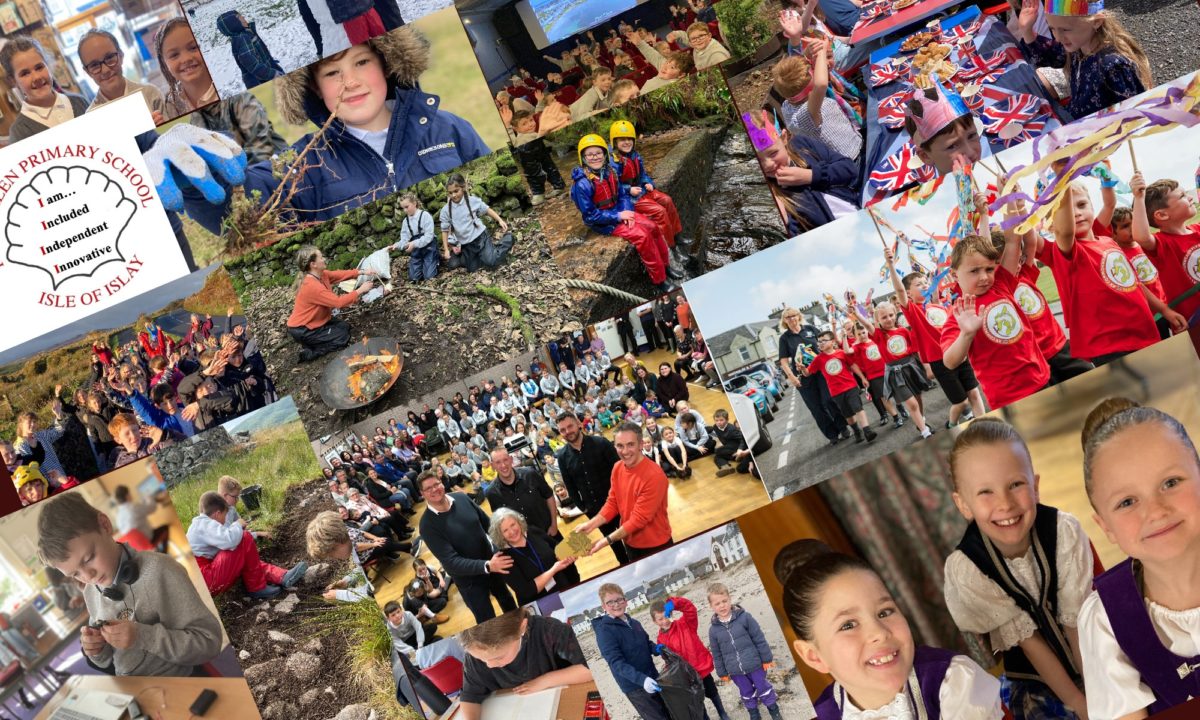Renewables Engineering Islay – March Diary
A key part of what we wanted to do with our project this year was to involve other primary schools on the islands. There are primary schools in Bowmore, Port Charlotte and Keills as well as Small Isles Primary School on the Isle of Jura. With National Science & Engineering Week coming up we decided that this would be an ideal time to get everyone together to work on a series of engineering challenges organised by Maggie Harrison, with the support of Jo Clark and Kate Brown.
Fairytale Engineering
The first session we ran was for children working at Early/First Level – from P1-P4. On the day we had 60 children meet together to work on some fairytale engineering. The focus was on developing creativity and children’s ideas for problem solving. The tasks were linked to the story of Rapunzel; first they had to build a tower for Rapunzel using mini marshmallows and cocktail sticks, exploring the strength of different shapes; then they had to work out a way for Rapunzel to escape the tower. Back in Port Ellen, P1/2/3 continued this learning, coming up with some amazingly good ideas – a glider, an elevator, a parachute, a hot air balloon and a zip wire.

At first I thought it was impossible but now I really want to do it again – Aiden, Port Charlotte Primary.
It was so much fun. My best bit was building the tower with marshmallows – Evie, Port Ellen
I loved getting to see the other school classes. I like working in a team. It was fun getting Rapunzel out of the tower – Callum, Bowmore Primary
Disaster!
Primary 4/5s from Port Ellen and Bowmore Primary Schools worked together to learn how engineering can be an important aspect of disaster relief. They thought about earthquakes and hurricanes that can devastate communities and lead to situations where emergency aid is unable to reach those who need it and how essential structures like air control towers need to withstand the powers of nature. Their first task was to design and build a mountain rescue stretcher to transport a patient (potato) to hospital; then all groups were given the same resources to build a tower which supported a tennis ball and withstood a hurricane!

I really enjoyed building with a time limit and enjoy building models that are real things but we make them mini – Millie, Port Ellen Primary
I loved it because we had to do challenges – James, Bowmore Primary
My class were all absolutely engaged in both activities. There were lots of discussions, problem solving and pride – Miss Brown, Port Ellen Primary.
Let’s Roll!
Older students met for a session looking at the engineering process, focussed on testing and improving. Groups of children from different schools built rollercoasters for marbles, trying to incorporate loop the loops and still catch the marble in a paper cup. Continuing on a marble theme, they then had to work out ways to increase the time taken for a marble to run down an inclined plane from 2.7 seconds to 10 seconds. It was fantastic to see the children from different schools work together, completely absorbed in solving the problem. Young STEM Ambassadors from Islay High School came along to help out on the day.

I enjoyed the session and learned a lot more about engineers – Neil, Port Charlotte Primary.
It was challenging because there were lots of different activities and we had a certain amount of time to do it in and we had to stick to the resources we had – Oliver, Keills. Primary
It was fun! – Elisa, Small Isles Primary.
I want to have another engineering day with all the schools again – Charlie, Port Ellen.
The activities were fun, engaging and appropriately challenging for the group. The children were actively involved and clearly developing their problem solving skills – Mrs Baker, Keills Primary
This session was held in Islay High School. Maggie Harrison and Maureen MacDonald are now in discussion with the Headteacher of the High School to look at delivering a similar workshop for S3 children.
Rescuing Humpty
National Science & Engineering week could not go by without involving out Pre-5 children. They had to find ways of rescuing Humpty so that he didn’t crack his head open getting down from the wall. Bubble wrap and cotton wool were turned into jackets and we also built a zip-wire and engineered baskets to help him get down from the wall safely!
Budget
| Date |
Purchases |
Cost |
| 22nd February |
4 copies Rosie Revere Engineer (for cluster schools) |
£42.15 |
| 22nd February |
External Hard Drive |
£47.68 |
| 6th March |
Pack cardboard tubes |
£18.05 |
| |
Solder |
£1.90 |
| |
3x Giant Lolly sticks |
£5.88 |
| |
12xSellotape |
£9.95 |
| |
3 packs masking tape |
£10.77 |
| |
Card |
£4.99 |
| |
Giant straws |
£18.98 |
| |
Wooden beads |
£4.98 |
| |
KNEX Imagination Makers Age 5-10 |
£30.26 |
| |
2xKNEX Imagine Age 7+ |
£61.02 |
| |
The Boy who harnessed the Wind |
£11.89 |
| |
Bioengineering Projects |
£12.49 |
| 7th March |
4XKNEX Renewable Energy (for cluster schools) |
£721.80 |
| Total Expenses |
|
|
| Remaining Money |
|
£3280.99 |




























































